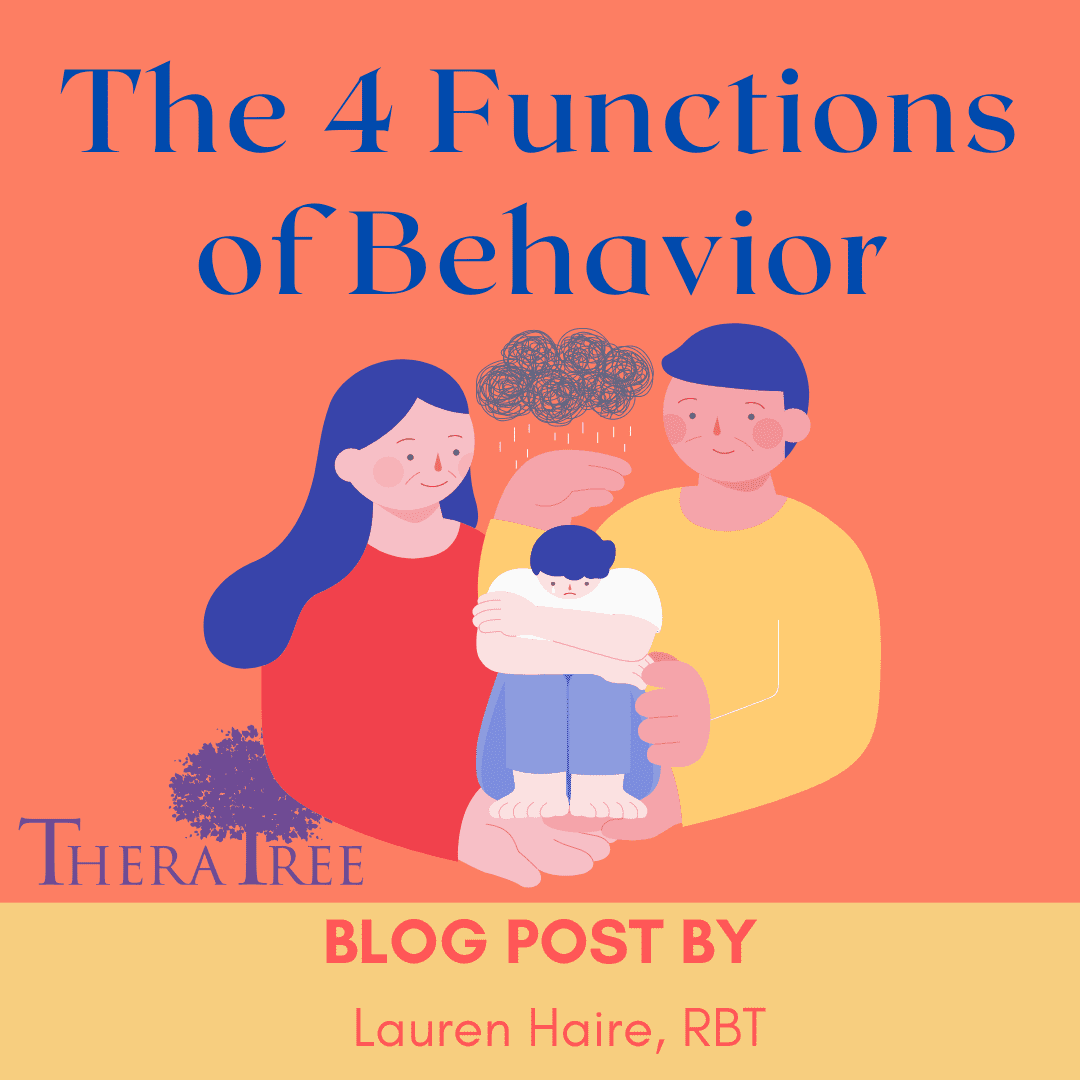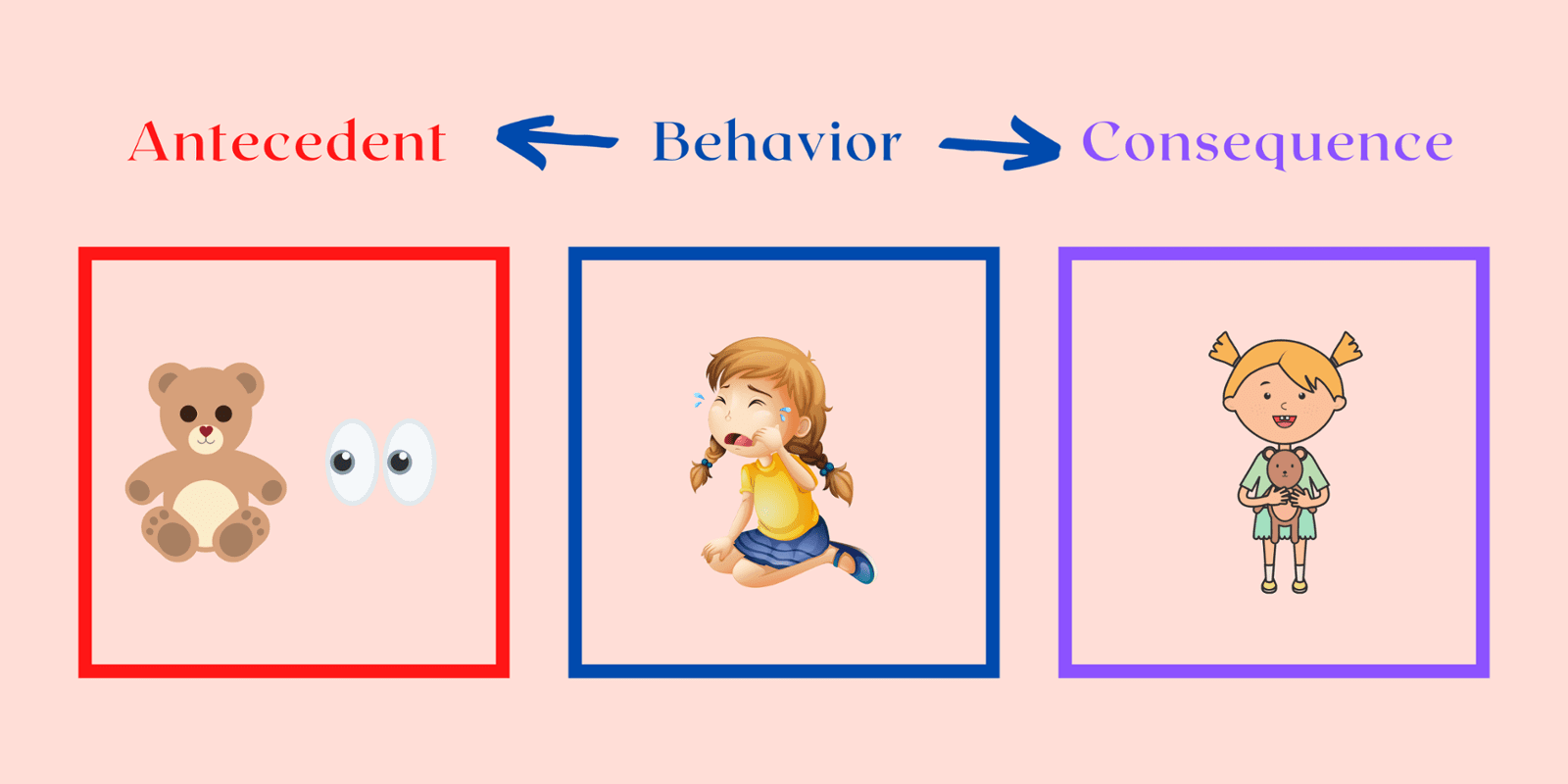
by Lauren Haire, RBT
Imagine this: You are grocery shopping and, in the aisle, next to you, you hear a child arguing with their parents. They won’t stay seated, and they are yelling. It is very common to watch a child “act out” in public with their parents. You sometimes think, “can they just tell them to stop and be quiet?” It is not always as simple as that.
As a parent and professional that works with children, it’s important for you to understand the 4 functions that drive behaviors that you see in children. Children with Autism can often struggle to communicate and engage in problem behavior to get their point across.
ABC's of Behavior
Behavior can be broken down into 3 parts to determine the function:
- The antecedent is what happened prior to the behavior of concern.
- The behavior is the behavior of concern.
- The consequence is what happened after the behavior was demonstrated.

The antecedent is that Lauren saw the toy, the behavior is when she began to cry, and the consequence was her mom giving her the toy. The function here is that Lauren was looking for access to a tangible (to get something.) Her mom gave her the toy which extinguished her crying behavior.
4 Functions: SEAT
A child's behavior is always functional - they're behaving a certain way for a reason. There are four main functions/reasons for a child's behavior. The easiest way to remember the functions of behavior is with this simple acronym. SEAT. Sensory, Escape, Attention, and Tangibles.
Sensory
The sensory function provides stimulation from the world to the brain. Sensory information can be in the form of touch, sound, visual, smell, taste, movement, or pressure.
When does it happen? Children seek out this sensory information because their body can’t get enough of it to use functionally OR they’re overriding a different sensation. In many children with Autism, this shows up as stimming. It can occur at any time, especially when anxious or excited.

How can I help? Redirect to more appropriate behavior that offers similar sensation. If you notice any behaviors that indicate a sensory deficit, you may benefit from receiving a free screening from one of our occupational therapists to address sensory needs. Occupational Therapy can address deficits related to sensory modulation (I.e. sensory over responsiveness or under responsiveness), sensory discrimination(i.e. attention), and sensory based motor(i.e. motor planning, balance, and postural adjustments.)
Example, a child may exhibit signs of overexcitement. You can relieve that need to release energy by allowing the child to go for a walk or riding a bike.
Escape
The function of escape removes undesired activities, interactions, or situations. The child is getting out or away from the situation, environment, or task.
When does it happen? It can occur when the tasks are understimulating, too easy, too hard, boring, or just completely undesired.
How can I help? Provide a “first, then” prompt, offer choices, or alter the length of task.
Example: “First clean up, then you may go watch tv.”

Attention
The function of attention provides access or awareness to/from people or interactions. It’s important to consider what kinds of attention the child likes and how much and when they’re currently getting attention.
When does it happen? It occurs when social attention is desired.
How can I help? You can provide positive reinforcement or attention before the behavior occurs, so they don’t “need” to do the problematic behavior.
Example: “Great job picking up. I like that you are following my directions.”
This statement gives positive reinforcement for picking up and following directions while feeding the potential attention seeking behavior. If we reinforce the negative attention seeking behavior, we could risk making the behavior worse. So, it’s important to reinforce only the positive things your child is doing during a difficult situation.

Tangibles
The function of access to tangibles provides preferred activities/items. This is what we usually think of as a “reward”. Although rewards don’t always need to be tangible to be considered reinforcing. We can use tangible rewards to help each then fade them.
When does it happen? It occurs when there is a preferred activity or item desired.
How can I help? There are several different ways you can approach this.

- You may teach the child to verbalize their wants and needs.
- If your child is nonverbal, teach sign language, use pictures to communicate (ABA uses Picture Exchange Communication), or assistive device like an iPad.
- Contrive teaching situations at home and this goes along with teaching the child to verbalize wants and needs.
For instance, let’s say your child loves to listen to songs on their iPad/tablet. As you listen to the song, try to pause and play the song. When the song is paused, verbally prompt the child to say ‘Play it.’ Praise the child heavily: ‘Great saying play it.’ And then immediately play the song. Again, this is just an example of how to use a highly preferred item as a teaching moment.
You can prompt your child to request based on their needs and level of language skills, then gradually fade the prompt. Remember, reinforcement increases the occurrence of behavior whether it is positive or negative.
We're Here to Help!
Don’t forget that “SEAT” is your go-to acronym when deciphering your child’s function of behavior. By contriving teaching situations in the natural environment, you can help your child practice communication skills, social skills, and give them the ability to communicate their sensory needs. Take ABC Data to keep track of behavior and present data to your pediatrician and/or your Board Certified Behavior Analyst (BCBA.) Your child may benefit from ABA Therapy or Occupational Therapy to assist in these behaviors!
Behavior can be complex! That’s why professionals have specialized in this science and are devoted to educate and help. If your child engages in challenging behaviors, you don’t have to figure it all out on your own!
We want to help. Call or text us at 270-688-8449 or email newpatients@theratreepeds.com to schedule a free screening or comprehensive evaluation. Let’s decrease your overwhelm and increase your relationship with your child together!
